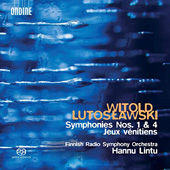

Symphony No. 1 (1947)
Jeux vénitiens (1961)
Symphony No. 4 (1992)
In a previous review of the Concerto for Orchestra by Witold Lutoslawski (1913-1994) I pointed out that "he combines great orchestration with stupendous steam locomotive momentum", a statement that could most certainly apply to the first movement of his 1947 Symphony No. 1. It must have jolted a few of the audience members attending its première right out of their seats. It's rhythmic pulse is flabbergasting and I'm sure would impose high technical demands on many of the best orchestras, but the members of the Finnish Radio Symphony Orchestra take it on with gusto and come out the other end unscathed. It's followed by a highly-charged and imposing slow movement which sounds like a deeply emotional, traumatic reaction to the war. The final movement resumes the highly agitated state of the first, with even more anger and resolve, imposing ever increasing demands on the woodwind and brass players, until near the end it abruptly revisits the mournful emotional state of the slow movement for a brief moment, only to flare-up again and cap the whole symphony with a blistering finish.
Now the Lutoslawski of the Jeux vénitiens is completely at odds with Lutoslawski the symphonist. Written during one of his experimental phases, it employs an 'aleatoric' approach in which some elements are left to chance. The notation is clearly laid out, but it's up to the individual performers to decide when to play these notes, which translates into a different listening experience everytime that piece is performed. This may be an interesting concept to investigate on a trial basis, but in my humble opinion, once a piece of music loses structural integrity, be it rhythmic, melodic or harmonic, it ceases to be music.
Symphony No. 4 from 1992 is laid out as a single movement and opens with a slow, deliberate but ominous throbbing momentum in the lower strings, and at times sounds like a great symphonic lament that brings to mind the symphonic work of Allan Pettersson. But then the sudden cacophonic outbursts in the central segment of the work quickly dispel that impression. But as in his First Symphony, it's the moments of forceful, pushing-forward momentum that impress and bring out a sense of urgency to the music. And again individual instrumental groups of the orchestra are subjected to stress tests along the way, as three quarters of the way through, everything builds to a powerful climax, followed by ghostly remnants of itself. You get the sense that it will end in quiet, unresolved desperation, but a final, defiant outburst brings the symphony to a violent end.
During the 20th century the 'symphony' was considered outdated and out of sync with the times, but I for one sure am glad that some composers bucked the trend and continued to create new and imposing statements in the genre. You could even say that Witold Lutoslawski, in his own highly independent fashion, reinvented the symphony to reflect 20th century Poland. There's only about a dozen recordings of these two symphonies available right now, and this new Ondine recording with conductor Hannu Lintu is easily an instant recommendation.
Jean-Yves Duperron - November 2018